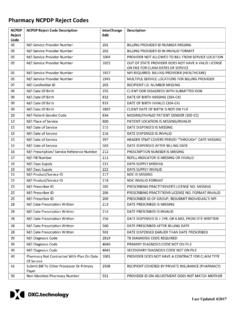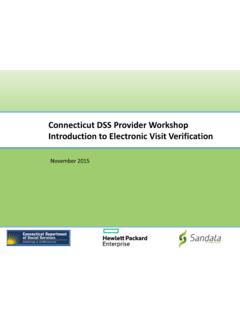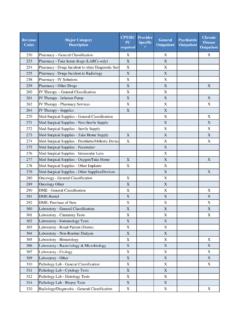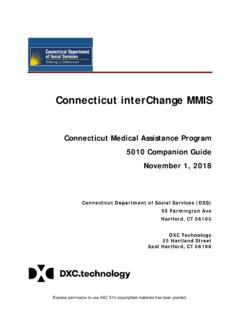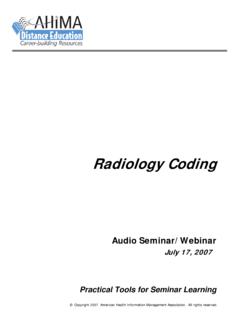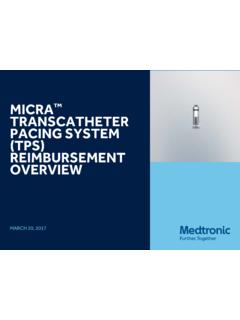Transcription of APR DRG FAQs - ctdssmap.com
1 Return to Top apr drg faqs *all red text is new for 11/16/2015 The following faqs address general topics related to APR DRGs. Additional detail information can also be found at the following links: Interim Billing Health Care Acquired Conditions (HCAC) / Present on Admission (POA) 3-Day Rule: Outpatient Services Prior to Inpatient Admissions Claims Paid Per Diem Rates Hospital Based Practitioners Inpatient 1. What is APR DRG? A. In general, every complete inpatient stay is assigned to a single diagnosis related group (DRG) using a computerized algorithm that takes into account the patient s diagnoses, age, procedures performed, and discharge status. Each DRG has a relative weight that reflects the typical hospital resources needed to care for a patient in that DRG relative to the hospital resources needed to take care of the average patient.
2 2. What are the characteristics of DRG payment? A. DRG payment defines the product of a hospital, thereby enabling greater understanding of the services being provided and purchased. B. Because payment does not depend on hospital-specific costs or charges, this method rewards hospitals for improving efficiency. C. Because DRGs for sicker patients have higher payment rates, this method encourages access to care across the full range of patient conditions. D. DRG payment rewards hospitals that provide complete and detailed diagnosis and procedure codes on claims, thereby giving payers, policymakers, and hospitals better information about services provided. 3. Who developed APR DRGs? A. APR DRGs were developed by 3M and the Children s Hospital Association (formerly the National Association of Children s Hospitals and Related Institutions (NACHRI)).
3 According to 3M, APR DRGs have been licensed by more than 20 state and federal agencies and by 1,600 hospitals. APR DRGs have been used to adjust for risk in analyzing hospital performance. 4. In order to be paid would my hospital need to buy APR DRG software? A. No. The CMAP claims processing system assigns the APR DRG to the claim and calculates the payment. The hospitals could opt to purchase the software to calculate the expected payment amount. Return to Top 5. What version of APR DRGs is being implemented? A. Version 31 of APR DRGs was implemented for inpatient claims with date of admission on or after January 1, 2015 and before October 1, 2015. B. Version 33 of APR DRGs was implemented for inpatient claims with date of admission on or after October 1, 2015. 6. When will the Inpatient APR DRG methodology be effective?
4 A. The Department of Social Services (DSS) has implemented APR DRG on 1/1/2015 for inpatient claims with admission on or after January 1, 2015. 7. When will the changes to hospital based practitioners billing be implemented? A. Beginning with inpatient admissions on or after January 1, 2015, all practitioners, including those who work for or are contracted by a hospital are required to bill practitioner services related to inpatient care on a professional claim form. Reimbursement will be via physician fee schedule. 8. What type of inpatient hospital claims will DRG pricing apply to? A. DRG pricing applies to most acute care hospital inpatient claims with the exception of chronic disease hospitals, psychiatric hospitals and free-standing birth centers with a date of admission of January 1, 2015 and forward.
5 For more information relating to inpatient admissions for behavioral health and rehabilitation claims, please refer to the Claims Paid Per Diem Rates link located at the top of this page. 9. Do DRG claims require additional information on the UB-04 claim form? A. Hospitals are not required to submit any additional information to support APR DRG processing. 10. Will hospitals be required to report DRG codes on their inpatient claims starting with date of admissions of January 1, 2015 and forward? A. No. Hospitals will not be required to submit the DRG code on inpatient claims. The CMAP claims processing system will assign the DRG to the claim and calculate the payment. 11. Will paper claims continue to be allowed to be billed with a date of admission of January 1, 2015 and forward? A. Yes. At this time there are no specific changes for paper claim submissions.
6 12. If a sterilization diagnosis is included on a DRG claim, does the sterilization form need to be submitted? Return to Top A. Yes. If a sterilization diagnosis is present on an inpatient claim; the Consent for Sterilization form will still be required. Please follow current guidelines to submit the consent form to DXC Technology. 13. Will the remittance advice (RA) be updated? A. Yes. A copy of the new RA has been posted to provider manual Chapter 5 Claim Submissions Information. 14. Will the X12 835 Healthcare Payment be updated? A. Yes. The X12 835 Health Care Payment has been updated to include the following DRG related fields: DRG code DRG Weight DRG Monetary Amount (MIA04 Claim DRG Amount) DRG Base Payment Amount Outlier Payment Amount with associated qualifier 15. What if the billed amount is less than the calculated DRG or per diem payment?
7 A. The hospital claim payment will not exceed the total billed amount of the claim. 16. Are there any impacts to getting Prior Authorization (PA) through CHN for medical admissions or CT BHP for behavioral admissions on January 1, 2015 and forward? A. Effective for admissions on or after April 1, 2015, inpatient services will no longer be reimbursed a per diem rate based exclusively on the DRG assignment. Services that are currently eligible for a per diem payment are identified by DRG assignments 740-776 (behavioral health) and 860 (rehabilitation). B. Please refer to the Provider Bulletin 2015-22 located on our Web site and from the Hospital Modernization Page, click on Provider Bulletins and Policy Transmittals link on the right hand side under Helpful Information & Publications. 17. Will the PA process change for an inpatient stay following observation?
8 A. For the observation status to become an inpatient admission, PA from the appropriate Administrative Services Organization (ASO) is required. If admission to the same hospital as an inpatient is approved, the date of admission will be the begin date of the observation. The hospital will not be separately reimbursed for the observation as it is included as part of the inpatient reimbursement. If the admission is to a different hospital, both hospitals will be reimbursed for their services. 18. Will the hospital need to obtain PA for observation without an admission? Return to Top A. Observation for clients with a behavioral health condition requires PA through the Connecticut Behavioral Health Partnership (CT BHP) and will be reimbursed by the Department for up to 23 hours if deemed medically necessary. If PA is not obtained for the observation services within the time frame allowed by DSS, the claim will be denied.
9 19. Should the hospital obtain PA through CHN CT for a medical admission with a diagnosis of alcohol withdrawal delirium (ICD-diagnosis code )? A. No. The hospital must obtain PA through CTBHP for all inpatient admissions with a diagnosis of alcohol withdrawal delirium (ICD-9-CM diagnosis code ) regardless of whether they are admitted and/or treated in a medical unit or a behavioral health unit. 20. Will the prior authorization (PA) on file cover the entire inpatient stay when the client has transferred from one unit in the hospital to another? A. Effective for admissions on or after April 1, 2015, a second per diem PA will, in addition to the authorization received at the time of the admission, is required by the hospital in order to be eligible for the per diem rate. Rehabilitation or behavioral health claims, currently paid at the per diem rate, will need PA reflecting a per diem on file.
10 If the hospital does not obtain a per diem PA at the time of service, the entire stay will pay based exclusively on the DRG assignment. 21. Will a PA for a medical inpatient stay be authorized retroactively if the client becomes eligible at a later date? A. The hospital must verify client eligibility through the Secure Web Portal or the Automated Eligibility Verification System (AEVS) and retain the eligibility verification number once retroactive eligibility for Medicaid has been verified for the dates of service for the inpatient stay. The request for authorization and a copy of the verification of eligibility should be submitted to Community Health Network (CHNCT) along with clinical information and documentation to substantiate the medical necessity of the admission. 22. How should the hospital bill services for a client admitted from the Emergency Department (ED)?
